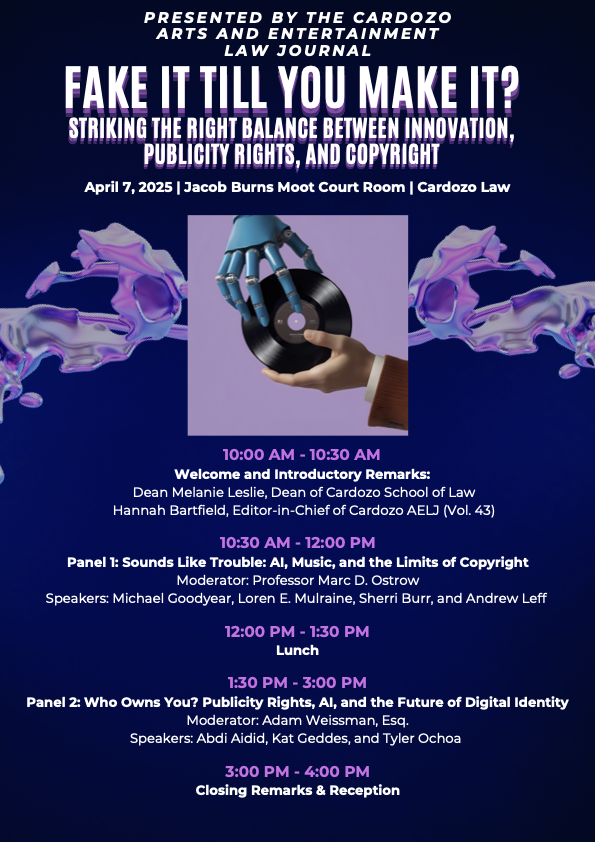“Going Once, Going Twice, Sold!” The Case for Resale Rights for Visual Artists in the United States

Resale rights can be understood to be a form of royalty payments that compensate visual artists for subsequent sales after the initial sale of their artwork. In contrast to the schemes available to music artists in the United States, who receive payment for subsequent use of their works through licenses for public performance, synchronization licenses, or mechanical licenses, visual artists lack the ability to profit from the resale of their creations. This discrepancy separates the United States from the approaches to resale rights in many European countries and other countries that have adopted this system. Countries that recognize resale rights for visual artists largely follow the droit de suite system, which extends beyond the finance-focused intentions of intellectual property protections to recognize moral rights in artistic creations. While there have been attempts to bring resale rights to visual artists in the United States, these efforts experienced limited success. For example, California is currently the only state to recognize resale rights for visual artists, limiting their applicability to in-state sellers and transactions. However, resale rights do exist in the non-fungible tokens (NFTs) industry. Smart contracts have built-in options for the implementation, calculation, and payment of resale royalties. While resale rights can be implemented via the initial sale contracts for the visual art industry, protection for this kind of right on a federal level could ensure that visual artists are protected economically and also send a message that artists are not valued simply for their ability to turn a profit, but also that the art they create is beneficial just by being art.
The history of resale rights helps to provide an explanation as to why they became a fixture of intellectual property laws in other countries, but not the United States. Copyrights in the United States have an economic foundation, and the country largely recognizes the commercial value of visual art, as reflected in the protections that copyright holders have against others profiting from their works without the copyright holder’s permission.[1] In contrast, countries like France, the birthplace of the resale rights scheme and the model for many other countries, recognize that all artists have moral rights in conjunction with commercial rights.[2] These rights include: the right of paternity, the right of integrity, the right to release, and the right to withdraw or modify.[3] These rights are continuous and absolute for all artists.[4] By extension, this “bundle of moral rights” also allows the concept of droit de suite to be implemented in the countries that recognize moral rights, especially since moral rights recognize the legacy of an artist’s work extends beyond the initial sale of the work.[5] The fight to implement droit de suite in France dates back to the 19th century, when The Societe des Amis du Luxembourg formed to enact droit de suite into French law. The group published a report emphasizing “the inherent unfairness that artists who create art can be reproduced, such as photographers and engraves, could profit from selling their artwork in multiples, whereas other visual artists would lose any profit if their work were resold.”[6] The “bundle of rights” that the United States recognizes for copyright holders are enumerated in The Copyright Act.[7] These include the right to reproduce and prepare derivative works, but these rights differ from resale rights because they do not recognize the original artist’s right to earn a portion of the profit from future sales of their artwork. Notably, federal law only protects the first sale of visual artwork.[8] The difference between countries that implement moral rights and countries that do not comes down to this: the former recognize a continuity between artists and their works, and the latter fails to do so.
Arguments for and against the implementation of droit de suite in the United States can be explained on a policy level. Opponents of implementation argue that the common-law system in the United States is ill-suited for droit de suite, which was formed largely in countries that follow a civil-law system.[9] These individuals argue that the common-law structure is ill-suited for droit de suite and resale rights for visual artists.[10] The differences in systems of law parallel the treatment of intellectual property as a commodity, versus recognition in other countries of artistic moral rights. Other concerns raised about implementing droit de suite laws in the Unites States include administrative costs which could be a barrier to enforcement; lack of transparency and its connection to privacy violations; and fears that the resale would primarily benefit already-successful artists, rather than up-and-coming ones looking to establish themselves in the market.[11] Moreover, opponents are concerned about a potential freeze in the art market with the implementation of droit de suite, raising concerns that if galleries, auction houses, independent sellers, or artists knew that resale payments would have to be made to the artist for any future sales, sellers in the art market would be less willing to make sales and buyers would be less willing to make purchases.[12]
On the other hand, supporters of implementing droit de suite argue that the system helps enforce fairness for all artists across disciplines. Proponents believe that non-visual artists should not be the only ones to benefit from future sales and uses of their art.[13] These individuals also argue assumptions that the art market would be negatively impacted with droit de suite are misplaced, and that an artist’s success can be attributed to factors like the experience and efforts of a dealer, the demand in the market, or even the work of the artist themselves.[14] Proponents further emphasize that resale rights would allow artists to achieve greater financial security over the course of their careers, undercutting the often-harmful and degrading trope of the “starving artist.”[15]
The world of NFTs could provide a workaround to the dilemma of a lack of resale rights for visual artists, essentially providing an option to contract into resale rights.[16] NFTs are defined and operated by a “smart contract,” which is a computer program that runs the operation of the NFT and uses blockchain technology to track ownership in digital assets.[17] These smart contracts can be coded to pay a resale royalty to the NFT creator if a resale is detected.[18] The process for resale payments has been automated with these smart contracts. Although NFT smart contracts are governed by contract law, one caveat to contracting around the first-sale doctrine under the Copyright Act is the possibility of the federal preemption of any state laws regarding changes in distribution rights and the first-sale doctrine.[19] However, it is crucial to note that since resale payments for NFTs are, in most circumstances, a private contract transaction, courts have made clear that such transactions fall outside the purview of preemption by federal law.[20] Because contracts frequently include terms on how licenses are handled in the transaction, as long as such terms are permissible in contract law and a purchaser agrees to the terms, a contractual approach to licensing would not interfere with distribution or the first sale doctrine under the Copyright Act.[21]
The origins and history of droit de suite and resale rights can explain why resale rights have been slow to gain traction in intellectual property law in this country, and why, to this day, resale rights have not been implemented at the federal level. There are arguments both in support and in opposition of resale rights for visual artists, with the strongest argument for the former being an attempt to ensure fairness across artists of different mediums and for the latter being a clash between such rights and the structure of federal intellectual property law. A potential NFT “smart contracts” approach could be one way to implement resale rights in transactions involving the sale of visual art, and there is some indication in case law that preemption, especially with regard to the Copyright Act, might not be an issue with these private contracts. However, although contracting around resale rights during transactions is certainly one approach to securing such rights for visual artists, a recognition of resale rights on the federal level would not only provide future financial security for visual artists, it would also send a message that the United States does not simply consider works of art a commodity.
Alice Darakhchava is a Second Year Law Student at the Benjamin N. Cardozo School of Law and an Articles Editor with the Cardozo Arts & Entertainment Law Journal. She is interested in copyright and the live arts industry but was inspired to explore the topic of this blog post by the Art Law class she is taking this semester.
[1] What Visual and Graphic Artists Should Know about Copyright, U.S. Copyright Office, https://www.copyright.gov/engage/visual-artists/ [https://perma.cc/7WN5-KN39].
[2] Michael B. Reddy, “The Droit D. Suite: Why American Fine Artist Should Have the Right to a Resale Royalty”, 15 Loy. L.A. Ent. L. J. 509, 514 (1995).
[3] See id. at 514.
[4] Id. at 514.
[5] Toni Mione, “Resale Royalties for Visual Artists: The United States Taking Cues from Europe,” 21 Cardozo Int’l Comp. Pol’y. & Ethics L. 461, 464 (2013).
[6] M. Elizabeth Petty, “Rauschenberg, Royalties, And Artists’ Rights: Potential Droit De Suite Legislation In The United States”, 22 Wm. & Mary Bill of Rts. J. 977, 984 (2014).
[7] 17 U.S.C. § 106.
[8] 17 U.S.C. § 106(3).
[9] Henry Hansmann & Marina Santilli, “Authors’ & Artists’ Moral Rights: A Comparative Legal and Economic Analysis”, 26 J. Legal Stud. 95, 142-43 (1997).
[10] See id.
[11] M. Elizabeth Petty, “Rauschenberg, Royalties, And Artists’ Rights: Potential Droit De Suite Legislation in The United States”, 22 Wm. & Mary Bill of Rts. J. 977, 1003 (2014).
[12] Michelle Janevicius, “Droit de Suite and Conflicting Priorities: The Unlikely Case for Visual Artists’ Resale Royalty Rights in the United States,” 25 DePaul J. Art Tech. & Intell. Prop. L. 383, 409 (2015).
[13] Allison Schten, “No More Starving Artists: Why the Art Market Needs a Universal Artist Resale Royalty Right,” 7 Notre Dame J. Int’l & Comp. L. 115, 129 (2017).
[14] Id. at 117.
[15] Janae Camacho, “‘This Artwork is Always on Sale’: The Need for a U.S. Resale Royalty Right for Digital Visual Artists in this Technological Age, and Proof of Concept Through the Blockchain and NFTs Explosion,” 18 Wash. J.L. Tech. & Arts 1, 21 (2023).
[16] Id. at 16.
[17] Michael D. Murray, “NFTs Rescue Resale Royalties? The Wonderfully Complicated Ability of NFT Smart Contracts to Allow Resale Royalty Rights to Allow Resale Royalty Rights,” 14 J. of L., Tech. & the Internet 208, 209 (2022-2023).
[18] utimaco, What is a Smart Contract in Blockchain?, https://utimaco.com/service/knowledge-base/blockchain/what-smart-contract-blockchain [https://perma.cc/5GJA-KSUL].
[19] This was, among other reasoning, the Ninth Circuit’s explanation for severing the California Resale Royalty Act, which is the only successful attempt to date to implement resale rights for visual artists into the law, and specifying that the Act applies only to transactions which take place within the state or those involving California artists. See, e.g., Close v. Sotheby’s, Inc., 894 F.3d 1061, 1070 (9th Cir. 2018).
[20] Close v. Sotheby’s, Inc., 894 F.3d 1061, 1071 (9th Cir. 2018).
[21] Michael D. Murray, “NFTs Rescue Resale Royalties? The Wonderfully Complicated Ability of NFT Smart Contracts to Allow Resale Royalty Rights to Allow Resale Royalty Rights,” J. of L., Tech. & the Internet 208, 218 (2022-2023).



